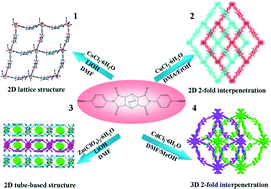Structural diversity of four new metal–organic frameworks with a curved tetracarboxdiimide dicarboxylic acid†
Abstract
Four new metal–organic frameworks (MOFs), {[Co2(L)2(DMF)3]·6.5DMF·5H2O}n (1), {[Cu(L)(H2O)]·2DMA}n (2), {[Zn2(L)(DMF)2(HCOO)2]·3DMF·2H2O}n (3), and {[Cd2(L)2(DMF)(H2O)(μ2-OH2)2]·3.5DMF·2H2O}n (4) (H2L = N-phenyl-N′-phenylbicyclo[2.2.2]oct-7-ene-2,3,5,6-tetracarboxdiimide dicarboxylic acid; DMA = N,N-dimethylacetamide; DMF = N,N-dimethylformamide) have been synthesized under solvothermal conditions. MOFs 1, 2 and 3 display various interesting two-dimensional (2D) structures, including 2D lattice structure, 2-fold interpenetrated 2D structure, and 2D tube-based network. MOF 4 features an interesting two-fold interpenetrated 3D structure possessing a 6-connected pcu network with the point symbol of {412·63}. Photoluminescent properties of MOFs 3 and 4 have been investigated in the solid state at room temperature.


 Please wait while we load your content...
Please wait while we load your content...